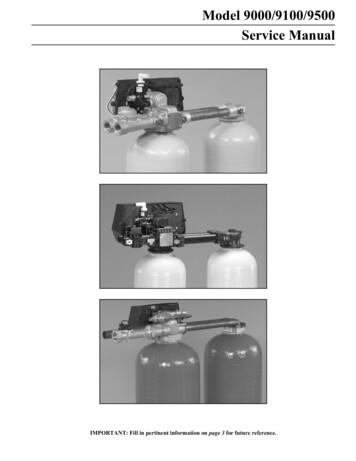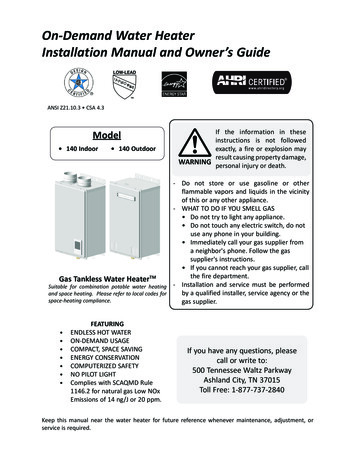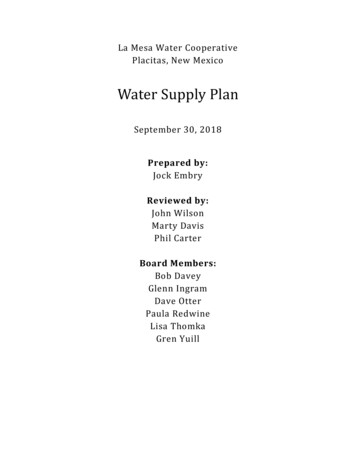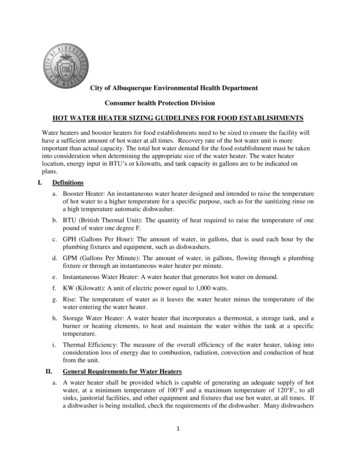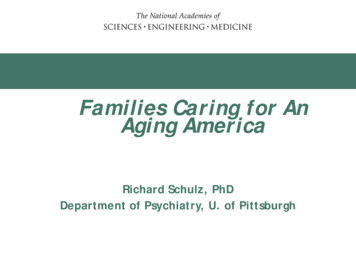
Transcription
WATER SCIENCE AND TECHNOLOGY BOARDFamilies Caring for AnAging AmericaRichard Schulz, PhDDepartment of Psychiatry, U. of PittsburghBOARD ON HEALTH CARE SERVICES
Download the report for free at:www.nationalacademies.org/caregivingBOARD ON HEALTH CARE SERVICES2
Sponsors of the StudyAlliance for Aging ResearchAlzheimer’s AssociationAnonymousArchstone FoundationCalifornia Health Care FoundationThe Commonwealth FundThe Fan Fox and Leslie R. Samuels FoundationHealth Foundation of Western and Central New YorkThe John A. Hartford FoundationMay and Stanley Smith Charitable TrustThe Retirement Research FoundationThe Rosalinde and Arthur Gilbert FoundationSanta Barbara FoundationTufts Health Plan FoundationU.S. Department of Veterans AffairsBOARD ON HEALTH CARE SERVICES3
Committee on Family Caregiving for Older AdultsRichard Schulz, Ph.D. (Chair)University of PittsburghLadson Hinton, M.D.University of California, DavisMaria P. Aranda, Ph.D., M.S.W., M.P.A.University of Southern CaliforniaPeter Kemper, Ph.D.Pennsylvania State UniversitySusan Beane, M.D.Healthfirst Inc.Linda Nichols, Ph.D.VA Medical Center MemphisUniversity of TennesseeSara J. Czaja, Ph.D.University of MiamiBrian M. Duke, M.H.A., M.B.E.Main Line HealthJudy Feder, Ph.D.Georgetown UniversityLynn Friss Feinberg, M.S.W.AARP Public Policy InstituteLaura N. Gitlin, Ph.D.Johns Hopkins UniversityLisa P. Gwyther, M.S.W.Duke UniversityRoger Herdman, M.D.RetiredCarol Rodat, M.A.Paraprofessional Healthcare Institute, Inc.Charles P. Sabatino, J.D.American Bar AssociationKaren Schumacher, Ph.D., R.N.University of NebraskaAlan Stevens, Ph.D.Baylor Scott & White HealthDonna Wagner, Ph.D.New Mexico State UniversityJennifer L. Wolff, Ph.D.Johns Hopkins UniversityBOARD ON HEALTH CARE SERVICES4
Family Caregiving for Older Adults Family caregiving has become an urgent public policyissue, linked to important social, health, and economicgoals Family caregivers provide the lion’s share of long-termservices and supports (LTSS) to older adults CBO estimates that the value of family caregivers’services to older adults was 234 billion in 2011 The Committee’s work calls into question practices thatassume the availability of a family caregiver withoutadequate support servicesBOARD ON HEALTH CARE SERVICES5
Charge to the CommitteeThree primary objectives To assess the prevalence and nature of familycaregiving of older adults To assess the impact of caregiving on individuals’health, employment, and overall well-being To recommend policies to address caregivers’ needsand to help minimize the barriers they encounter inacting on behalf of an older adultBOARD ON HEALTH CARE SERVICES6
Rapidly Rising Numbers of Older Adults and FewerFamily Caregivers to Help Them Historic demographic changes By 2030, 72.7 million adults age 65 ( 20% of U.S. population) Increasing diversity but national surveys are not powered forsubgroup analyses Fastest growing cohort of older adults are those age 80 Most likely to have a physical or cognitive impairment Demand for caregivers is growing rapidly Gap between the demand for and supply of family caregivers isincreasing The size of American families is shrinking and the makeup offamilies is changingBOARD ON HEALTH CARE SERVICES7
Changing Racial and Ethnic Diversity, U.S. Older Adults, 2010 to 2040 (in millions)SOURCE: Adapted from Frey, 2014BOARD ON HEALTH CARE SERVICES
Older Adults’ Need for Help Varies Widely At least 17.7 million individuals are family caregivers (relatives,partners, friends, or neighbors) who assist someone age 65 withphysical, mental, cognitive, or functional limitations) (2011) Care may be episodic, daily, occasional, short- or long-term About 6.3 million older adults receive a family caregiver’s helpwith household tasks or self-care because of health orfunctioning reasons (2011) An additional 3.5 million older adults receive help becausethey have dementia (2011) 1.1 million reside in nursing homes (2011) but there are verylimited data on their family caregivers Some need short-term help after a hospital stay or noncatastrophic injury; others will never need a caregiver’s helpBOARD ON HEALTH CARE SERVICES9
8.5 million caregivers provide help to 4.9 million high-need older adults (personswith dementia and/or 2 or more self-care needs), 2011NOTES: As reported by Medicare beneficiaries age 65 and older (or their proxy) for the prior month. Self-care activities includebathing, dressing, eating, toileting, or getting in and out of bed. “Probable dementia” includes individuals whose doctor said theyhad dementia or Alzheimer’s disease and individuals classified as having probable dementia based on results from a proxy screeninginstrument and several cognitive tests. Excludes nursing home residents.SOURCE: Data from the 2011 NHATSBOARD ON HEALTH CARE SERVICES10
Average Number of Years Caregiversof Older Adults Spend CaregivingYearsPercent ofCaregivers1 year or less15.32 to 4 years34.75 to 10 years34.9More than 10 years15.1NOTE: Includes family caregivers of Medicare beneficiaries age 65 andolder in the continental United States who resided in community orresidential care settings (other than nursing homes) and received helpwith self-care, mobility or household activities for health orfunctioning reasons. Respondents were asked “How many years haveyou been helping the care recipient?” Responses were given in wholenumbers.SOURCE: Data from the 2011 NHATS and the companion NSOCBOARD ON HEALTH CARE SERVICES11
The Family Caregiver Role is Far More Complex andDemanding than in the Past Family caregivers have always been the primary providers of olderadults’ long-term services and supports such as: Household tasks and self-care (getting in and out of bed,bathing, dressing, eating, or toileting) Today, they are also tasked with managing difficult medicalprocedures and equipment in older adults’ homes, overseeingmedications, and monitoring symptoms and side effects, andnavigating complex health and LTSS systems Including health care services that, in the past, were deliveredonly by licensed health care personnel (injections, IVs) And, often, without training, needed information, orsupportive servicesBOARD ON HEALTH CARE SERVICES12
The Health Impact of Caregiving is Highly Individualand Dependent on Personal and Family Circumstances For some, caregiving instills confidence, provides meaning and purpose,enhances skills, and brings the caregiver closer to the older adult For others, caregiving leads to emotional distress, depression, anxiety,and impaired physical well-being The intensity and duration of caregiving and the older adult’s level ofimpairment are predictors of adverse consequences Family caregivers spending long hours caring for someone withadvanced dementia are especially vulnerable Other risk factors are low socioeconomic status, high levels ofperceived suffering of the care recipient, living with the carerecipient, lack of choice in taking on the caregiving role, poorphysical health, lack of social support, and a physical homeenvironment that makes care tasks difficultBOARD ON HEALTH CARE SERVICES13
Family Caregiving of Older Adults Can PoseSubstantial Financial Risks Many family caregivers of older adults report moderate to high levelsof financial strain Family caregivers at the greatest risk of financial harm include thosewho: are caring for significantly impaired older adults are low-income or have limited financial resources reside with or live far from the care recipient have limited or no access to paid leave (if they are employed) Caregivers may also incur substantial out-of-pocket expenses: medical/medication associated costs assistive devices/home modifications home health aidesBOARD ON HEALTH CARE SERVICES14
Family Caregiving and Employment Related Costs More than half of family caregivers are employed part- or full-time Caregivers may lose income, Social Security/ retirement benefits, andcareer opportunities if they have to modify work hours or leave theworkforce Many employed family caregivers do not have unpaid or paid leavebenefits at work or are not eligible for the unpaid protections of theFamily and Medical Leave Act (FMLA): Daughters, sons-in-laws, stepchildren, grandchildren, siblings Employees of small firms Federal, state, and municipal laws provide some protections foremployed family caregivers, but little is known about their impact oncaregivers of older adults or employersBOARD ON HEALTH CARE SERVICES15
Programs and Supports for Caregivers of Older Adults An abundance of evidence on a wide array of interventions andsupportive approaches to support family caregivers is available Our approach to the review of the evidence: Defined intervention broadly – therapeutic strategies (e.g., skillbuilding), care delivery models, programs and services Considered interventions for caregivers caring for older adultswith a wide range of conditions Considered five categories of outcomes – psychological, physical,social/support service use, economic and positive effects Considered the heterogeneity of the caregiving experience andthe caregiving trajectory and how interventions address diversity Considered the role of technology in delivering services/support Considered issues associated with implementation of interventionsBOARD ON HEALTH CARE SERVICES16
Framework for Caregiver InterventionsSOCIETALPolicies, Legislation / Regulatory Structures, Insurance ReimbursementPolicies (e.g., Patient Protection and Affordable Care Act / NationalAlzheimer’s Project Act / Family Medical Leave Act / Medicare)ORGANIZATIONALINTERVENTIONWorkplace / Area Agency on Aging / Alzheimer’s Association(e.g., respite programs; employee leave programs)INDIVIDUAL/SOCIALCare Recipient (CR)Caregiver (CG)(e.g., Skill-building, counseling,provision of education)Family(e.g., family-based therapy)Friends / NeighborsCHARACTERISTICS Diversity, Size,Languages, Government,Regulatory Processes, CultureCHARACTERISTICS Degree of Formality,Structure, Communication/DisseminationCR CHARACTERISTICS Age, Chronic Condition/Illness,Length of Time of Illness, Gender, Culture/Ethnicity,Education, Health LiteracyCG CHARACTERISTICS Age, Relationship to the CR,Yrs. of Caregiving Health Status, Health Literacy,Race/Ethnicity and Culture, Occupational Status,Education, GenderFAMILY CHARACTERISTICS Race/Culture/Ethnicity,Cohesiveness, Size, Relationship to CGFIGURE 1: Organizational Framework for Reviewing Family Caregiving InterventionsBOARD ON HEALTH CARE SERVICES17
Programs and Supports for Family Caregiversof Older Adults Evidence indicates that a wide variety of intervention approaches(education and skills training, counseling, self-care and relaxationtraining, environmental modifications, respite programs, carecoordination) can improve caregiver outcomes: caregiver confidence and ability to manage daily care challenges both the caregiver’s and care recipient’s quality of life may delay older adults’ institutionalization and reduce rehospitalization, shorten hospital stays Effective interventions: incorporate an assessment of caregivers’ needs and preferenceswhich are tailored accordingly actively involve the caregiver in learning a skillBOARD ON HEALTH CARE SERVICES18
Programs and Supports for Family Caregiversof Older Adults Most intervention trials have focused on caregivers of older adultswith Alzheimer’s Disease and on a single caregiver Additional work is needed to identify optimal strategies todisseminate and maintain effective interventions and programs Additional research is needed to determine the effectiveness ofinterventions in diverse groups of caregivers Technologies (e.g., Internet, mobile apps) are increasingly being usedto support family caregivers: Technology-based interventions are feasible, acceptable, and canimprove caregiver outcomes Few studies have considered cost issues, issues of diversity Most studies have focused on caregivers of older adults with ADRDBOARD ON HEALTH CARE SERVICES19
Evidence on an Array of Interventions to SupportFamily Caregivers is Available The most effective interventions are tailored to caregivers’ risks, needs,and preferences Thus, it is clear that caregiver assessment is essential Education and skills training can improve caregiver confidence andability to manage daily care challenges Counseling, self-care, relaxation training, and respite programs canimprove both the caregiver’s and care recipient’s quality of life Some research suggests that personal counseling and care managementmay delay older adults’ institutionalization and reduce re-hospitalization Numerous barriers limit caregivers’ access to such services Additional research is needed to determine the effectiveness ofinterventions in diverse groups of caregiversBOARD ON HEALTH CARE SERVICES20
Some Examples Deloitte’s Paid Family Leave Program 16 weeks of paid leave per year Bond with child through birth/adoption; care for spouseparent, child, sibling WELLMED Caregiver SOS program Caregiver referral integrated into eclotronic medicalrecord Embedded caregiver training and support in clinics Molina Healthcare—Promising Practices Evidence based screening Caregiver training Community resource guide Improved care coordinationBOARD ON HEALTH CARE SERVICES21
Washington State Program: Delay use of Medicaid Paid family caregivers Caregiver Assistance Services Training and Education Specialized Medical Equipment and Supplies Clinical or therapeutic services for caregiver toremain in roleBOARD ON HEALTH CARE SERVICES22
Defining the Problem: Family Caregivers in CareDelivery Family caregivers interact with varied professionals within andacross diverse service delivery settings Provide information about older adults’ health and treatments Participate in medical decision-making Support, enact, oversee older adults’ care planThe current care delivery orientation is person-focused Provider payment is directed to the insured individual Health professional education is focused on supporting patients Clinical assessments and data infrastructure capture patientlevel information Bioethical orientation is toward support of patient autonomy Legal and regulatory emphasis is on data privacy and security,risk managementBOARD ON HEALTH CARE SERVICES23
Implications of Care Delivery Paradigm Care providers generally do not: Identify older adults who rely on a family caregiver Identify family caregivers who are present in care processes Assess family caregiver knowledge, skill, or capacity to provideassistance in light of their personal circumstances and resources Provide support to family caregivers or initiate appropriatereferrals Family caregivers are often implicitly assumed to be available andable to provide care - even as they are marginalized or excludedfrom care planning Missed opportunities for better preparation and support ofcaregivers, with consequences for care quality and outcomes of bothcaregivers and older adultsBOARD ON HEALTH CARE SERVICES24
Missed Opportunities and DrawbacksCaregivers who are not adequately prepared or supported experience: Stress and anxiety, fear unintentionally making an error or causinginjury Suffer burnout or depression when they are asked to do too muchOlder adults also suffer when caregivers are not adequately prepared orsupported. Older adults may: Be marginalized in their own care, or receive care inconsistentwith their preferences Experience delayed or unmet service needs Be at risk for inappropriate medication use Experience neglect or potential abuse Receive poor quality or fragmented care Incur avoidable service use, such as ED visits or hospitalizationBOARD ON HEALTH CARE SERVICES25
Priority Areas for Action1. Identification, assessment, and support of familycaregivers in delivery of care2. Inclusion of both family and caregiver experiences inquality measurement3. Support of family caregivers through health informationtechnology4. Preparation of care professionals to provide person- andfamily-centered careBOARD ON HEALTH CARE SERVICES26
RecommendationsA Vision for the Future: No less than a transformation in the policies and practices affectingthe role of families in the support and care of older adults The focus of the nation’s health care reforms should evolvefrom person-centered to person- and family-centered care Support of family caregivers should be recognized as anintegral part of the nation’s collective responsibility for caringfor older adults with health and functional needs The Committee calls upon the new Administration to take steps toaddress the health, economic, and social issues facing familycaregivers of older AmericansBOARD ON HEALTH CARE SERVICES27
Recommendations1. The Secretary of HHS, working with the Secretaries of Labor andVeterans Affairs, and others, should create and implement aNational Family Caregiver Strategy that includes:A. Effective mechanisms to ensure that family caregivers areroutinely identified and their needs are assessed andsupportedB. Medicare and Medicaid payment reform to motivateproviders to engage family caregivers effectivelyC. Training of health care and social service providers torecognize, engage, and support family caregiversBOARD ON HEALTH CARE SERVICES28
Caregiver AssessmentBOARD ON HEALTH CARE SERVICES29
RecommendationsNational Family Caregiver Strategy that includes:D. Dissemination and funding for evidence-based caregiver servicesE. Evaluation and adoption of federal policies that provideeconomic support to working caregiversF. Expanded data collection to improve reporting and analysis onthe experience of family caregiversG. A multi-agency research program to evaluate caregiverinterventions in “real-world” settings and across diverseconditions and populations.BOARD ON HEALTH CARE SERVICES30
Recommendations2. States that have not addressed the needs of family caregivers ofolder adults should learn from the states that provide servicesand supports to caregivers and implement similar programs3. The Secretaries of HHS, Labor, and Veterans Affairs should workwith leaders in health care and LTSS, technology, andphilanthropy to establish a public-private innovation fund toaccelerate the pace of change4. All the above actions should explicitly address the diversity ofolder adults and their family caregiversBOARD ON HEALTH CARE SERVICES31
Some Hopeful Signs RAISE (Recognize, Assist, Include, Support, andEngage) Family Caregivers Act Credit for Caring Act—tax credit up to 3000 forfinancially helping relative Caregiver Advise, Record, Enable (CARE) Act –discharge planning, Adopted in 30 statesBOARD ON HEALTH CARE SERVICES32
Questions?Download the report for free at:www.nationalacademies.org/caregivingBOARD ON HEALTH CARE SERVICES33
Caregivers may lose income, Social Security/ retirement benefits, and career opportunities if they have to modify work hours or leave the workforce Many employed family caregivers do not have unpaid or paid leave benefits at work . or are not eligible for the unpaid protections of the Family and Medical Leave Act (FMLA):






